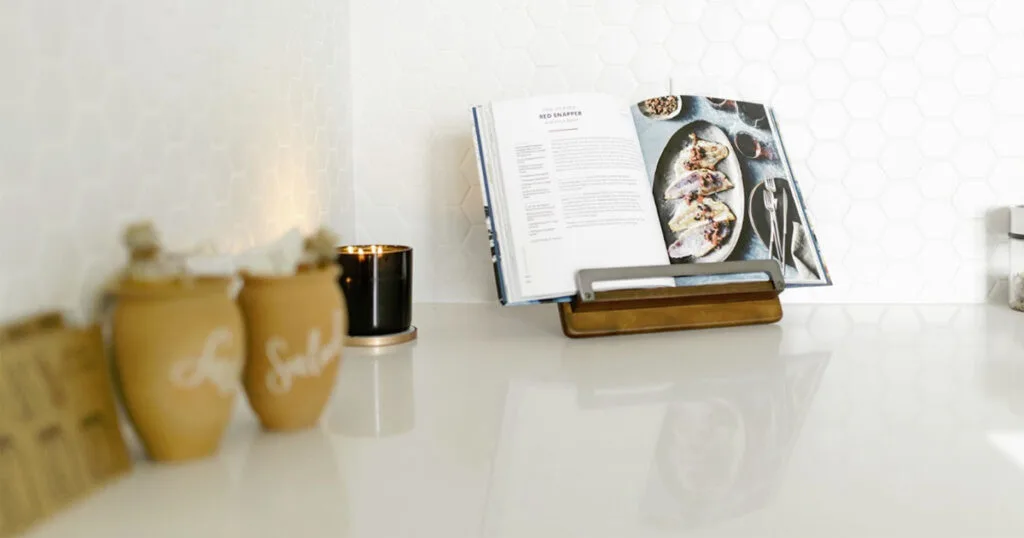Whether you’re a foodie looking to share your delicious creations or a designer venturing into cookbook creation, you need to take the design process seriously.
To help you get started, here’s a look at the main factors involved, from choosing the perfect font and incorporating tantalizing photography to adopting user-friendly formatting.

Choosing the Ideal Typeface: Making Your Recipes Stand Out
The right font does more than add flair. It directly communicates your content’s context. As such, it’s important to select a typeface that isn’t only elegant, but also easily readable. After all, you want your readers to enjoy not just the aesthetic of your cookbook, but the healthy recipes as well.
Consider sans serif fonts for body text, as their simplicity ensures readability while maintaining modernity. For headlines or titles, use stylish yet legible fonts to balance sophistication and function.
Understanding Color Schemes: How to Enhance Appetite & Mood
The use of color in your cookbook can be a powerful tool. This not only helps to evoke specific emotions, but it also triggers the appetite.
Warm colors like reds and yellows stimulate hunger, making them perfect for highlighting recipes or adding a backdrop. Neutral tones give an elegant aesthetic that pairs well with refined cuisine.
However, never overlook the power of white space. Its use provides balance and draws attention to your food photography.
Essentially, pick color schemes while being mindful of their psychological effects on mood and appetite, and keep this consistent throughout.
From Sketch to Layout: Planning Your Cookbook Pages with Purpose
Effective layout design isn’t just about aesthetics, as it’s also about usability. To ensure your cookbook is both engaging and easy-to-follow, consider the following:
- Allocate enough space for instructions. Cramming text leaves no room for note-taking.
- Incorporate margins. They offer a visual breather and evoke an organized look.
- Position images strategically. Couple them with their respective recipes to provide visual guidance.
By focusing on these elements, you’ll develop pages that are not only visually pleasing but reader-friendly as well. This is particularly important if you’re focusing on an audience with specific dietary requirements, such as a gluten intolerance, as you want to ensure that no mistakes are made in interpreting your recipes.
Captivating Snaps: Utilizing Photography in your Cookbook Design
Photography plays a vital role, turning delicious dishes into a visual feast. Start by hiring professional photographers; their expertise can make food look more tantalizing. Use photos to break up large chunks of text and provide visual instructions on process steps or final presentation.
You can even test out your design by ordering tailor-made photo albums from sites like Mixbook. This allows you to evaluate how images fit with the overall aesthetic of your cookbook prior to full publication.
Designing Catchy Covers and Spines: Making a Lasting First Impression
Never underestimate the impact of your cookbook’s cover. It’s the first thing potential buyers see, making it your opportunity to grab attention. The cover should give a glimpse of what makes your book unique, be that through enticing food photography, intriguing titles, or both.
Furthermore, don’t forget about the spine. It needs to stand out on a packed bookshelf. Ensure it includes easily readable text and carries part of the cover design for consistency. A captivating exterior will pique curiosity and invite readers to explore inside.
Practicality Meets Aesthetic Appeal: Incorporating Formatting
Designing a cookbook isn’t just about packing in eye-catching elements. It’s crucial to ensure your recipes are easy to follow.
To do this, look at integrating bullet points or boxed sections for extra clarity on steps or ingredients. Also, experiment with different type sizes, but aim for fonts that are large enough to read comfortably while cooking.
Most importantly, keep the text consistent and segregated from images, preventing any mix-up between visuals and instructions.
Wrapping Up
It’s a good idea to see effective cookbook design in action, so as well as taking these tips onboard, be sure to browse your favorite cook books in order to see how they go about implementing them.
